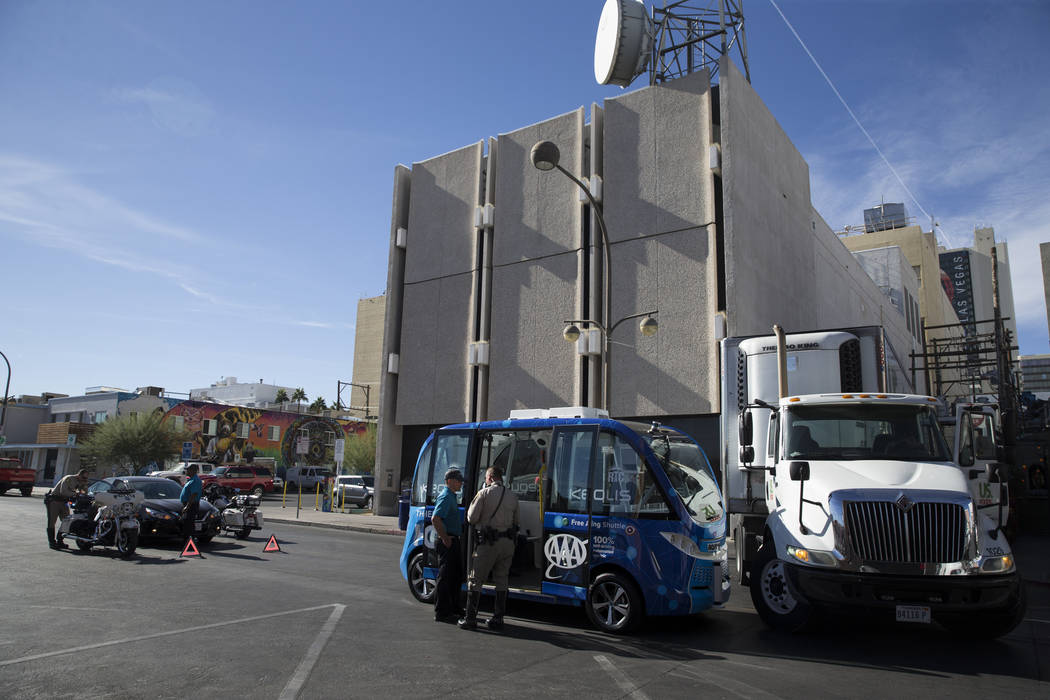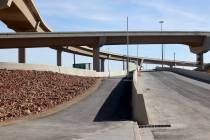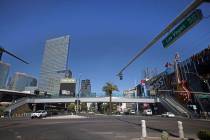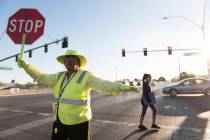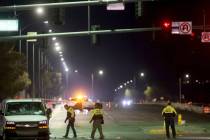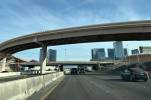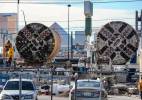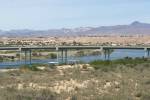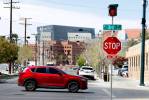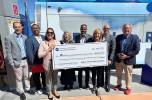Self-driving vehicle operators learn from 2017 Las Vegas crash
With autonomous vehicles becoming increasingly common on the nation’s roads, especially in Las Vegas, safety is always a concern for motorists and pedestrians.
With a bevy of self-driving activity occurring in the Las Vegas Valley, from autonomous Lyft rides on the Strip to the self-driving shuttle program in downtown Las Vegas that ended last year, safety is a major component in all the programs.
A November 2017 crash involving an autonomous shuttle and a delivery truck downtown gave the emerging technology a black eye.
The shuttle pilot project — a collaboration by Keolis, Navya, the city of Las Vegas, AAA and the Regional Transportation Commission of Southern Nevada — saw a crash occur on the first day of its public rollout in what a Keolis executive described as the worst timing in the world.
The National Transportation Safety Board conducted a crash investigation and on Thursday announced that it found, as believed early on, that the driver of the delivery truck was at fault in the crash. The driver was cited by the Metropolitan Police Department the day of the crash.
The report also noted that the self-driving shuttle’s attendant lacked access to a manual controller to operate the vehicle, which it said was a contributing factor to the collision that occurred on 6th Street near Carson Avenue.
Keolis spokesperson Chris Parker said the company learned from the incident and made the appropriate changes to increase safety measures.
“We made continuous improvements to the service throughout the year and one of the things was the manual controller,” Parker said. “When it was needed it was set up in a position that was easily accessible by the operator. If the operator needed to be able to utilize the controller, it is in a place that was easy for them to access.”
There were no injuries to the seven passengers and one attendant aboard the shuttle or to the driver of the truck, and the crash caused only minor damage to the lower left front of the shuttle’s body and a minor abrasion to the truck’s tire.
Since the crash was not a catastrophic event, the NTSB said it wouldn’t have investigated the incident if an autonomous vehicle had not been involved.
“The NTSB would normally not investigate a minor collision, but the involvement of a highly automated vehicle warranted having our investigators examine the circumstances surrounding the collision,” Kris Poland, deputy director of the NTSB’s highway safety office, said in a statement. “We wanted to examine the process of introducing an autonomous shuttle onto public roads as well as the role of the operator, the vehicle manufacturer and the city. The NTSB also examined the technology and the safety considerations that were in place at that time.”
Given the newness of integrating autonomous technology on roadways, small-scale projects like the almost 1-mile loop the downtown shuttle operated on is a perfect way to test and learn the technology, according to RTC CEO Tina Quigley.
“There’s only so much that you can do under enclosed, controlled environments,” she said. “That is why we do small-scale, slow speed testing deployments.”
The autonomous shuttle program that ran from November 2017 to November 2018 transported more than 32,000 individuals on nearly 5,000 trips, leading the RTC, Keolis and Las Vegas to plan a larger-scale project.
Plans call for the operation of a longer autonomous shuttle route downtown with Keolis, this time between the Bonneville Transit Center and the Las Vegas Medical District on about a 4-mile loop. The vehicles would operate in real time traffic traveling down a long stretch of Bonneville Avenue/Alta Drive.
“Moving people safely, quickly and conveniently in and around the Las Vegas Medical District is a focus for the City of Las Vegas as we continue to build on the world-class medicine offered in the heart of our community,” said Las Vegas Mayor Carolyn Goodman in a statement last year.
U.S. 95 closure
Overnight lane reductions this week will affect traffic on a portion of U.S. Highway 95 downtown.
The two inside lanes of U.S. 95 southbound will close to traffic between 8 p.m. Tuesday and 4 a.m. Wednesday, the Nevada Department of Transportation announced last week.
The work to be carried out is routine maintenance from normal wear and tear and not related to damage resulting from a pair of earthquakes that were felt in Southern Nevada earlier this month, according to NDOT spokesman Tony Illia.
Send questions and comments to roadwarrior@reviewjournal.com. Please include your phone number. Follow @mickakers on Twitter.



